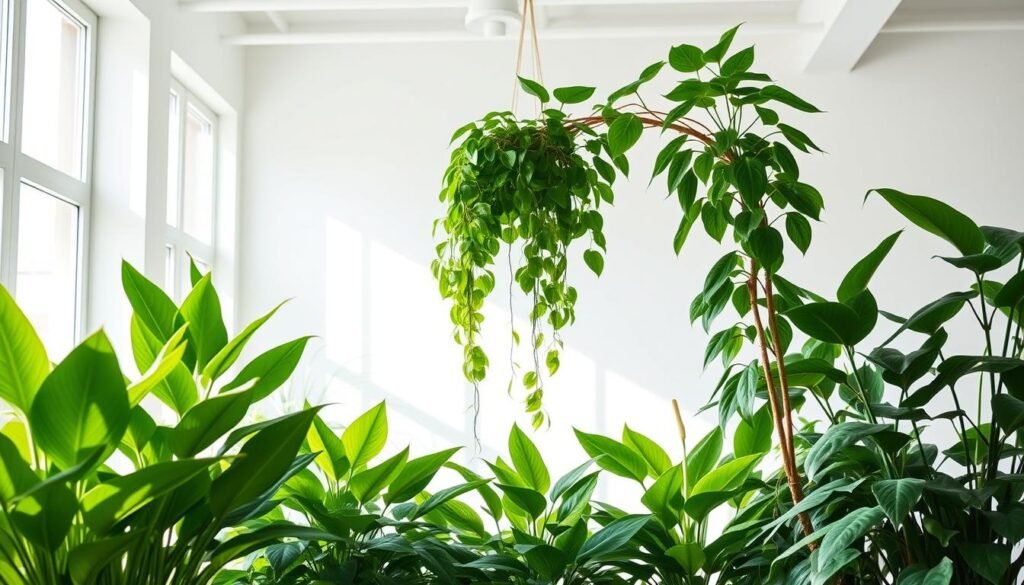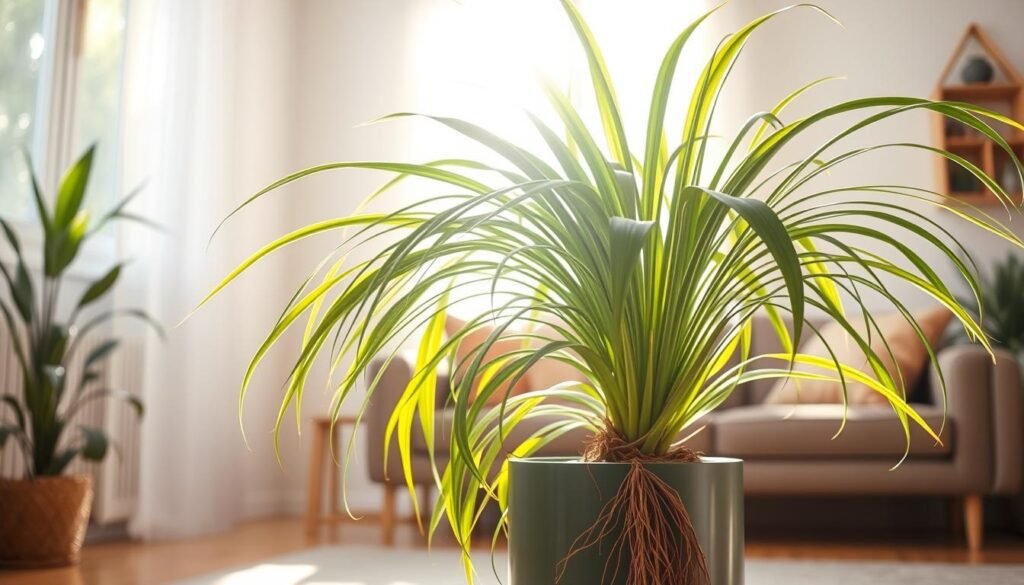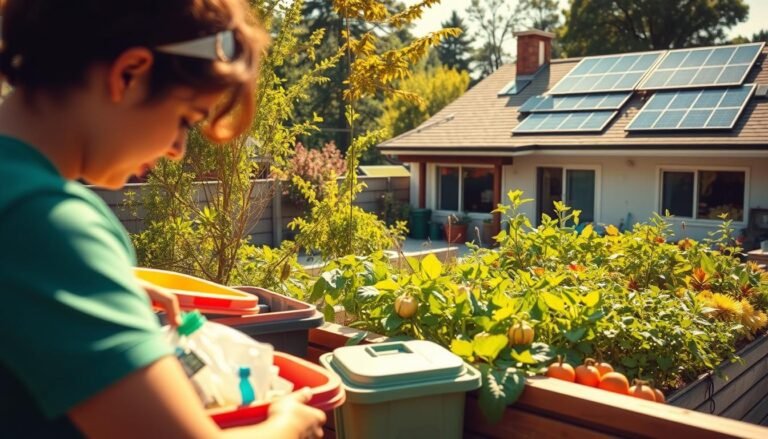Having indoor plants can be a simple yet effective way to enhance the air quality in your home. NASA research scientists have found that certain plants can help combat sick building syndrome, a condition that affects people in poorly ventilated buildings.
By incorporating these eco-friendly solutions into your home, you can create a healthier living space. Not only do indoor plants purify the air, but they also add a touch of nature to your decor.
Key Takeaways
- Certain indoor plants can help reduce sick building syndrome.
- NASA research supports the benefits of indoor plants for air quality.
- Incorporating plants into your home is an eco-friendly solution.
- Plants can enhance the aesthetic of your living space.
- Improving air quality can lead to a healthier living environment.
The Hidden Dangers of Indoor Air Pollution
The air inside our homes can be more hazardous than the air outside, harboring pollutants that affect our well-being. Indoor air pollution is a significant concern, particularly in Australian homes where the climate can lead to increased time spent indoors.
Common Indoor Air Pollutants in Australian Homes
Indoor pollutants come in two major varieties: particulates such as dust, mold spores, and pollen; and volatile organic compounds (VOCs) which are gases released from paints, fabrics, wallpaper, carpeting, plastics, and solvents commonly found in most homes. These pollutants can originate from various sources, including building materials, household cleaning products, and even some types of furniture.
Health Impacts of Poor Indoor Air Quality
Exposure to indoor air pollutants can lead to a range of health issues, from mild irritation of the eyes, nose, and throat to more severe conditions like respiratory diseases and even cancer. Poor indoor air quality can exacerbate asthma and other respiratory conditions, making it essential to identify and mitigate sources of indoor pollution. By understanding the risks associated with indoor air pollution, Australians can take steps to improve their indoor air quality, creating healthier living environments.
Maintaining good indoor air quality is crucial for our health and well-being, and there are several strategies that can be employed to reduce indoor air pollution, including the use of air-purifying plants.
How Plants Naturally Purify Indoor Air
The NASA Clean Air Study revolutionized our understanding of indoor air quality by highlighting the role of plants. Indoor plants are not just aesthetically pleasing; they are also effective at improving indoor air quality by removing pollutants.
The NASA Clean Air Study Findings
The NASA Clean Air Study tested 19 different species of plants to determine their effectiveness in cleaning the air. The study found that in just 24 hours, the leaves and roots of the plants removed up to 87% of the formaldehyde, benzene, and trichloroethylene from the air. This groundbreaking research demonstrated the potential of indoor greenery to significantly improve air quality.
The study’s findings have been instrumental in promoting the use of plants for air purification in homes and offices. By understanding which plants are most effective, individuals can make informed decisions about the types of plants to incorporate into their indoor spaces.
Plant Filtration Mechanisms Explained
Plants purify the air through several mechanisms. The leaves absorb pollutants such as formaldehyde and benzene, while the roots and soil microorganisms work together to break down trichloroethylene. Additionally, plants release moisture into the air through transpiration, which can help to humidify dry indoor environments.
Understanding these mechanisms is crucial for maximizing the air purification benefits of indoor plants. By selecting the right plants and providing them with optimal care, individuals can enhance the air quality in their homes.
Indoor Plants That Improve Air Quality Naturally: The Science Behind It
By delving into the science behind indoor plants, we can better appreciate their role in improving indoor air quality. Indoor plants are not just aesthetically pleasing; they are also powerful tools in the quest for cleaner air.

Phytoremediation Process
Phytoremediation is the process by which plants remove pollutants from the air. This natural process involves plants absorbing airborne chemicals through their foliage, breaking them down in their root systems, and converting them into harmless compounds like sugars, amino acids, and other useful “building blocks” of life.
The phytoremediation process is a complex one, involving various mechanisms that work together to purify the air. Some of the key ways plants achieve this include:
- Absorbing pollutants through their leaves
- Breaking down toxins in their root systems
- Releasing clean oxygen back into the air
By incorporating plants into our indoor spaces, we can harness the power of phytoremediation to improve air quality naturally.
Transpiration and Humidity Benefits
In addition to phytoremediation, plants also contribute to improved indoor air quality through transpiration. Transpiration is the process by which plants release water vapor into the air, which can help maintain a healthy humidity level indoors.
Some of the benefits of transpiration include:
- Regulating indoor humidity levels
- Reducing the risk of dry skin and respiratory issues
- Creating a more comfortable indoor environment
By choosing the right plants for our indoor spaces and understanding their role in transpiration, we can create a healthier and more comfortable living environment. This is a key aspect of eco home tips that can make a significant difference in our daily lives.
Peace Lily: The Versatile Air Purifier
The Peace Lily is renowned for its elegant white blooms and exceptional air-purifying capabilities. This versatile plant is not only a beautiful addition to any indoor space but also a powerful tool in improving air quality.
Pollutants Removed by Peace Lilies
Peace Lilies are known to effectively remove a variety of harmful pollutants from the air, including alcohols, acetone, trichloroethylene, benzene, and formaldehyde. By removing these toxins, Peace Lilies contribute to a healthier indoor environment, reducing the risk of respiratory issues and other health problems.
Care Guide for Australian Conditions
To ensure your Peace Lily thrives in Australian conditions, it’s essential to provide the right care. Peace Lilies prefer indirect light and consistently moist soil. Avoid placing them in direct sunlight, which can cause the leaves to become scorched. Water your Peace Lily regularly, but make sure not to overwater, as this can lead to root rot. With proper care, your Peace Lily will continue to purify the air and add beauty to your home.
Snake Plant: The Bedroom Air Cleaner
As a natural air purifier, the snake plant is particularly suited for bedrooms where air quality can significantly impact sleep quality. Snake plants are known for their effectiveness in removing harmful pollutants such as formaldehyde, benzene, xylene, toluene, and nitrogen oxides from the air.
Night-time Oxygen Production Benefits
One of the unique benefits of having a snake plant in the bedroom is its ability to produce oxygen at night. Unlike many plants that release carbon dioxide in the dark, snake plants continue to produce oxygen, making them an ideal bedroom companion for improving sleep quality.
- Enhances sleep quality through continuous oxygen production
- Removes harmful pollutants from the air
- Thrives in low-light conditions, perfect for bedrooms with limited natural light
Low-Maintenance Care Instructions
Caring for a snake plant is straightforward, making it perfect for busy individuals or those new to indoor gardening. To keep your snake plant healthy:
- Water sparingly, allowing soil to dry between waterings
- Place in a variety of lighting conditions, from bright to low light
- Maintain average room temperatures between 15°C to 30°C
By following these simple care instructions, you can enjoy the air-purifying benefits of snake plants in your bedroom, promoting a healthier sleep environment.
Spider Plant: Perfect for Beginners
The spider plant is a popular choice among beginners due to its ease of care and air-purifying properties. It’s a versatile plant that can thrive in various indoor conditions, making it perfect for those new to indoor gardening.
Child and Pet-Safe Air Purification
One of the significant advantages of spider plants is their safety around children and pets. Unlike some other houseplants, spider plants are non-toxic, making them an excellent choice for families. They are effective at removing air pollutants such as formaldehyde, which is emitted by cigarette smoke, dry cleaning, synthetic carpeting, and fingernail polish.
Benefits for Families:
- Non-toxic to children and pets
- Effective air purifiers
- Easy to care for
Propagation Tips for Multiple Plants
Spider plants are easily propagated, allowing you to create multiple plants from one. To propagate, simply cut off the baby plants (or spiderettes) that grow on the ends of the stems, pot them in well-draining soil, and keep the soil moist until roots develop.
| Propagation Step | Description |
|---|---|
| 1. Cut the Spiderette | Remove the baby plant from the mother plant. |
| 2. Pot the Cutting | Place the cutting in a pot with well-draining soil. |
| 3. Water | Keep the soil moist until roots develop. |

By following these simple steps, you can enjoy the benefits of spider plants throughout your home, improving indoor air quality naturally.
Devil’s Ivy (Pothos): The Adaptable Air Freshener
In the quest for cleaner indoor air, Devil’s Ivy emerges as a champion, capable of thriving in various Australian home environments. This versatile plant is not only aesthetically pleasing but also a potent air freshener, removing common toxins such as benzene and xylene from the air.
Versatility in Australian Home Environments
Devil’s Ivy is highly adaptable, making it suitable for a range of indoor conditions found in Australian homes. It can thrive in bright, indirect light as well as in low-light conditions, making it perfect for rooms with limited natural light. Its ability to grow in various temperatures and humidity levels adds to its versatility, allowing it to flourish in different parts of the home.
Key benefits of Devil’s Ivy include its ability to purify the air and its low-maintenance requirements, making it an ideal choice for busy homeowners or those new to indoor gardening.
Growth Patterns and Maintenance
Devil’s Ivy is a trailing plant that can grow quite vigorously if not pruned regularly. It can be trained to climb up trellises or left to cascade down, offering flexibility in how it’s displayed. To maintain its health and appearance, regular watering and occasional fertilization are recommended. It’s also important to prune the plant to encourage new growth and prevent it from becoming too leggy.
By incorporating Devil’s Ivy into your indoor space, you not only enhance the air quality but also add a touch of natural beauty to your home. Its ease of care and air-purifying capabilities make it a valuable addition to any Australian home.
Australian Native Plants for Indoor Air Purification
Incorporating Australian native plants into your home decor not only enhances aesthetic appeal but also improves indoor air quality. Native plants are known for their air-purifying properties, making them an excellent choice for indoor spaces.
Wax Flower and Lilly Pilly Benefits
Wax flowers and Lilly Pilly are two Australian native plants that offer significant benefits for indoor air purification. Wax flowers are known for their beautiful, fragrant blooms and ability to remove pollutants from the air. Lilly Pilly, on the other hand, is a versatile plant that not only purifies the air but also provides a natural source of antioxidants.
| Plant | Air Purification Benefits | Aesthetic Appeal |
|---|---|---|
| Wax Flower | Removes pollutants, fragrant blooms | Beautiful flowers, pleasant fragrance |
| Lilly Pilly | Air purification, antioxidant source | Versatile, attractive foliage |
Growing Native Plants Indoors
Growing native Australian plants indoors requires some care and attention. To ensure they thrive, it’s essential to provide them with the right conditions. Most native plants prefer well-draining soil and adequate sunlight. Regular watering and fertilization can also help promote healthy growth.
For eco-friendly home tips, consider repurposing containers and using natural fertilizers to care for your native plants. This not only benefits the environment but also enhances the overall health of your plants.
Rubber Plant: The Formaldehyde Fighter
The Rubber Plant is renowned for its ability to remove formaldehyde, a common toxin found in many Australian homes. Formaldehyde is emitted by various household products, including furniture, adhesives, and some types of flooring. By having a Rubber Plant in your home, you can significantly reduce the levels of this harmful chemical, contributing to a healthier indoor environment.
Effectiveness Against Common Household Toxins
Rubber Plants are not only effective against formaldehyde but also contribute to overall indoor air quality. They are capable of removing other pollutants, thus improving the air you breathe. Studies have shown that having plants like the Rubber Plant in indoor spaces can lead to a reduction in airborne toxins, enhancing the well-being of occupants.
Optimal Growing Conditions in Australia
To maximize the air-purifying benefits of the Rubber Plant, it’s essential to provide optimal growing conditions. Rubber Plants prefer bright, indirect light and moderate watering. In Australia’s climate, it’s crucial to adjust watering according to the season, ensuring the soil is not too dry or waterlogged. With proper care, Rubber Plants can thrive and continue to purify the air effectively.
By incorporating Rubber Plants into your indoor space, you can enjoy not only their aesthetic appeal but also their significant benefits in improving air quality. Their ability to combat formaldehyde and other pollutants makes them a valuable addition to any home or office.
Boston Fern: The Humidity Hero for Dry Australian Climates
The Boston fern is a versatile plant that not only purifies the air but also helps maintain humidity levels indoors. This makes it an ideal choice for dry Australian climates where indoor air can become particularly arid.
Boston ferns are known for their lush green fronds and ability to thrive in humid environments, making them perfect for adding moisture to dry indoor spaces.
Benefits for Different Australian Regions
In regions like Western Australia and the Northern Territory, where dry conditions are prevalent, Boston ferns can significantly improve indoor humidity. In southern states like Victoria and Tasmania, they can still provide benefits during the dry winter months. By maintaining a more balanced indoor humidity, Boston ferns can help prevent dry skin and respiratory issues.
Placement and Watering Requirements
To get the most out of your Boston fern, it’s essential to place it in a spot with indirect light and maintain regular watering. The soil should be kept moist but not waterlogged. Regular misting can also help maintain the humidity around the plant, creating a beneficial microclimate.
By following these care guidelines, you can enjoy the humidity benefits of Boston ferns in your home, improving your indoor air quality and overall comfort.
Creating an Indoor Plant Purification System
Maximizing indoor air quality involves more than just having plants; it requires a thoughtful purification system. To achieve this, it’s essential to understand how to strategically place plants throughout your home and combine different species for comprehensive purification.
Strategic Plant Placement for Maximum Effect
Strategic placement of plants is crucial for maximizing their air-purifying benefits. Plants should be placed in areas where they can effectively remove pollutants, such as near common sources of indoor pollution like cooking areas or living rooms with electronic devices.
- Place plants in bedrooms to improve sleep quality by purifying the air at night.
- Position plants near windows to maximize their exposure to natural light, enhancing their growth and air-purifying capabilities.
- Distribute plants throughout the home to ensure comprehensive coverage and air purification.
Combining Plants for Comprehensive Purification
Combining different plant species can enhance the overall effectiveness of your indoor plant purification system. Different plants are effective against different pollutants, so a variety ensures broader protection.
| Plant Type | Primary Pollutants Removed | Benefits |
|---|---|---|
| Peace Lily | Ammonia, Benzene | Effective in bathrooms and kitchens |
| Snake Plant | Formaldehyde, Nitrogen Oxides | Ideal for bedrooms due to night-time oxygen production |
| Spider Plant | Airborne particles, Formaldehyde | Easy to propagate and maintain |
By understanding the strengths of different plants and strategically placing them throughout your home, you can create a comprehensive indoor plant purification system that significantly improves your indoor air quality.
“The right indoor plants can transform your home into a healthier, more refreshing environment.”
Caring for Your Air-Purifying Indoor Garden
To maintain a healthy air-purifying indoor garden, it’s crucial to understand the specific needs of your plants. Proper care ensures that your plants continue to purify the air effectively and thrive in your home.
Seasonal Care Adjustments for Australian Climate
The Australian climate varies significantly across different regions, and your plant care routine should adjust accordingly. For instance, during the warmer months, plants may require more frequent watering due to increased evaporation rates. Conversely, in cooler months, watering can be less frequent as the plants’ growth slows down.
- In summer, ensure plants are not exposed to direct sunlight for extended periods to prevent scorching.
- In winter, keep plants away from drafts and heating vents to maintain a stable temperature.
Adjusting your care routine seasonally will help maintain the health and effectiveness of your air-purifying garden. For more information on houseplants that clean the air, you can visit this resource.
Troubleshooting Common Plant Problems
Even with proper care, plants can sometimes encounter problems. Common issues include yellowing leaves, pest infestations, and fungal infections. Identifying the problem early is key to resolving it effectively.
Common Issues and Solutions:
- Yellowing Leaves: Often a sign of overwatering or underwatering. Adjust your watering schedule accordingly.
- Pest Infestations: Inspect your plants regularly. Use organic pest control methods if necessary.
- Fungal Infections: Improve air circulation around your plants and avoid overwatering to prevent fungal growth.
By being proactive and addressing issues promptly, you can keep your air-purifying garden healthy and thriving.
Where to Buy Air-Purifying Plants in Australia
If you’re in Australia and seeking to enhance your indoor air quality, there are multiple sources for air-purifying plants. These plants can be found in various nurseries and garden centers across the country, as well as through online retailers.
Nurseries and Garden Centres by Region
Many Australian cities have local nurseries and garden centers that stock a variety of air-purifying plants. In major cities like Sydney and Melbourne, you can find specialized plant stores that focus on indoor plants. For instance, in New South Wales, nurseries like Diggers Club offer a range of plants suitable for indoor air purification.
Online Options and Approximate Costs
For those who prefer shopping online, there are several Australian retailers that deliver air-purifying plants directly to your doorstep. Here are some options:
| Retailer | Plant Options | Approximate Cost |
|---|---|---|
| Amazon Australia | Snake Plant, Peace Lily, Spider Plant | $15-$30 |
| Planters Online | Rubber Plant, Devil’s Ivy, Boston Fern | $20-$40 |
| Diggers Club | Peace Lily, Spider Plant, Lilly Pilly | $15-$35 |
When purchasing online, consider factors like delivery costs and plant care instructions to ensure your new plants thrive.
Air-Purifying Plants Safe for Homes with Pets and Children
When it comes to improving indoor air quality, many homeowners are turning to air-purifying plants, but it’s crucial to choose varieties that are safe for pets and children. While these plants offer numerous benefits, some can be toxic if ingested.
Non-Toxic Options for Family Homes
For families, Spider Plants and Prayer Plants are excellent choices. They are not only effective at purifying the air but are also non-toxic to pets and children. Another safe option is the Parlor Palm, known for its elegant appearance and air-purifying capabilities.
| Plant | Air Purification Benefits | Pet & Child Safety |
|---|---|---|
| Spider Plant | Removes formaldehyde and xylene | Non-toxic |
| Prayer Plant | Purifies air, improving indoor quality | Non-toxic |
| Parlor Palm | Removes benzene and trichloroethylene | Non-toxic |
Plants to Avoid if You Have Pets or Small Children
Some air-purifying plants can be harmful if ingested. Peace Lilies and Snake Plants, while popular for their air-purifying qualities, contain toxic compounds that can be dangerous to pets and children.
By choosing the right plants, you can enjoy cleaner air and a safer home environment for your family.
Conclusion: Breathing Easier with Nature’s Help
Incorporating air-purifying indoor plants into our homes is a simple yet effective way to improve indoor air quality. By understanding the benefits of plants like Peace Lilies, Snake Plants, and Spider Plants, we can create a healthier living environment. These plants not only remove pollutants but also contribute to a more balanced indoor ecosystem.
Using indoor plants to enhance air quality is a natural and sustainable approach. It’s a step towards reducing our reliance on mechanical air purifiers and embracing nature’s help. By choosing the right plants and caring for them properly, we can breathe easier and enjoy a healthier indoor space.
As we’ve seen, various indoor plants offer unique benefits, from removing common toxins to thriving in different Australian climates. By incorporating these plants into our indoor spaces, we can significantly improve air quality and overall well-being. Embracing indoor plants is a straightforward way to harness nature’s help and create a healthier home environment.





